An Off-Site Construction Digital Twin Assessment Framework Using Wood Panelized Construction as a Case Study
Abstract
:1. Introduction
2. Research Methodology
3. Literature Review
3.1. Digital Twin (DT) in the Manufacturing Industry
A Digital Twin is an integrated Multiphysics, multiscale, probabilistic simulation of an as-built vehicle or system and uses the best available physical models, sensor updates, fleet history, etc., to mirror the life of its corresponding flying twin [11].
3.2. Digital Twin in the Construction Industry
3.2.1. Construction Digital Twin or Off-Site Construction Digital Twin
3.2.2. Off-Site Construction Digital Twin Application
4. Off-Site Construction Processes
5. Off-Site Construction Digital Twin Model: 4 Parts
6. Off-Site Construction Digital Twin Maturity Level (OCDTML)
6.1. OCDTML Design
6.2. OCDTML Assessment Process
7. Results and Discussion
8. Conclusions
Author Contributions
Funding
Acknowledgments
Conflicts of Interest
References
- Gerth, R.; Boqvist, A.; Bjelkemyr, M.; Lindberg, B. Design for construction: Utilizing production experiences in development. Constr. Manag. Econ. 2013, 31, 135–150. [Google Scholar] [CrossRef]
- Changali, S.; Mohammad, A.; van Nieuwland, M. The Construction Productivity Imperative; McKinsey & Company: New York, NY, USA, 2015. [Google Scholar]
- Kritzinger, W.; Karner, M.; Traar, G.; Henjes, J.; Sihn, W. Digital Twin in manufacturing: A categorical literature review and classification. IFAC-PapersOnLine 2018, 51, 1016–1022. [Google Scholar] [CrossRef]
- Boje, C.; Guerriero, A.; Kubicki, S.; Rezgui, Y. Towards a semantic Construction Digital Twin: Directions for future research. Autom. Constr. 2020, 114, 103179. [Google Scholar] [CrossRef]
- Strother, J.B.; Ulijn, J.M.; Fazal, Z. Drowning in Data: A Review of Information Overload within Organizations and the Viability of Strategic Communication Principles. In Information Overload; John Wiley & Sons, Ltd.: Hoboken, NJ, USA, 2012; pp. 231–250. [Google Scholar] [CrossRef]
- Grieves, M. Digital Twin: Manufacturing Excellence through Virtual Factory Replication. 2015. Available online: https://www.researchgate.net/publication/275211047_Digital_Twin_Manufacturing_Excellence_through_Virtual_Factory_Replication (accessed on 10 September 2021).
- Tao, F.; Zhang, H.; Liu, A.; Nee, A.Y.C. Digital Twin in Industry: State-of-the-Art. IEEE Trans. Ind. Inform. 2019, 15, 2405–2415. [Google Scholar] [CrossRef]
- Lopez, D.; Froese, T.M. Analysis of Costs and Benefits of Panelized and Modular Prefabricated Homes. Procedia Eng. 2016, 145, 1291–1297. [Google Scholar] [CrossRef]
- Altaf, M.S.; Al-Hussein, M.; Yu, H. Wood-Frame Wall Panel Sequencing Based on Discrete-Event Simulation and Particle Swarm Optimization. In Proceedings of the Wood-Frame Wall Panel Sequencing Based on Discrete-Event Simulation and Particle Swarm Optimization, Sydney, Australia, 9–11 July 2014. [Google Scholar] [CrossRef] [Green Version]
- Moreno, A.; Velez, G.; Ardanza, A.; Barandiaran, I.; de Infante, Á.R.; Chopitea, R. Virtualisation process of a sheet metal punching machine within the Industry 4.0 vision. Int. J. Interact. Des. Manuf. 2017, 11, 365–373. [Google Scholar] [CrossRef]
- Glaessgen, E.; Stargel, D. The Digital Twin Paradigm for Future NASA and U.S. Air Force Vehicles. In Proceedings of the 53rd AIAA/ASME/ASCE/AHS/ASC Structures, Structural Dynamics and Materials Conference, Honolulu, HI, USA, 23–26 April 2012. [Google Scholar] [CrossRef] [Green Version]
- Lee, J.; Bagheri, B.; Kao, H.-A. A Cyber-Physical Systems architecture for Industry 4.0-based manufacturing systems. Manuf. Lett. 2015, 3, 18–23. [Google Scholar] [CrossRef]
- Schroeder, G.; Steinmetz, C.; Pereira, C.E.; Muller, I.; Garcia, N.; Espindola, D.; Rodrigues, R. Visualising the digital twin using web services and augmented reality. In Proceedings of the 2016 IEEE 14th International Conference on Industrial Informatics (INDIN), Poitiers, France, 19–21 July 2016; pp. 522–527. [Google Scholar] [CrossRef]
- Yao, X.; Zhou, J.; Lin, Y.; Li, Y.; Yu, H.; Liu, Y. Smart manufacturing based on cyber-physical systems and beyond. J. Intell. Manuf. 2019, 30, 2805–2817. [Google Scholar] [CrossRef] [Green Version]
- Konstantinov, S.; Ahmad, M.; Ananthanarayan, K.; Harrison, R. The Cyber-physical E-machine Manufacturing System: Virtual Engineering for Complete Lifecycle Support. Procedia CIRP 2017, 63, 119–124. [Google Scholar] [CrossRef]
- Uhlemann, T.H.-J.; Lehmann, C.; Steinhilper, R. The Digital Twin: Realizing the Cyber-Physical Production System for Industry 4.0. Procedia CIRP 2017, 61, 335–340. [Google Scholar] [CrossRef]
- Rasheed, A.; San, O.; Kvamsdal, T. Digital Twin: Values, Challenges and Enablers From a Modeling Perspective. IEEE Access 2020, 8, 21980–22012. [Google Scholar] [CrossRef]
- Zheng, Y.; Yang, S.; Cheng, H. An application framework of digital twin and its case study. J. Ambient Intell. Human Comput. 2019, 10, 1141–1153. [Google Scholar] [CrossRef]
- Ameri, F.; Sabbagh, R. Digital Factories for Capability Modeling and Visualization. In Proceedings of the IFIP International Conference on Advances in Production Management Systems (APMS), Iguassu Falls, Brazil, 3–7 September 2016; pp. 69–78. [Google Scholar] [CrossRef] [Green Version]
- Laakso, M.; Kiviniemi, A. The ifc standard—A review of history, development, and standardization. J. Inf. Technol. Constr. (ITcon) 2012, 17, 134–161. [Google Scholar]
- Lee, Y.-C.; Eastman, C.M.; Lee, J.-K. Validations for ensuring the interoperability of data exchange of a building information model | Elsevier Enhanced Reader. Autom. Constr. 2015, 58, 176–195. [Google Scholar] [CrossRef]
- Wilson, J.S. Sensor Technology Handbook; Newnes: Amsterdam, The Netherlands, 2005; Available online: https://login.proxy.hil.unb.ca/login?url=https://search.ebscohost.com/login.aspx?direct=true&db=nlebk&AN=117182&site=ehost-live&scope=site (accessed on 14 February 2022).
- Lu, W.; Tan, T.; Xu, J.; Wang, J.; Chen, K.; Gao, S.; Xue, F. Design for manufacture and assembly (DfMA) in construction: The old and the new. Archit. Eng. Des. Manag. 2021, 17, 77–91. [Google Scholar] [CrossRef]
- Pandey, P.S.; Raghuwanshi, S.K.; Kumar, S. Recent Advances in Two-Dimensional Materials-Based Kretschmann Configuration for SPR Sensors: A Review. IEEE Sens. J. 2022, 22, 1069–1080. [Google Scholar] [CrossRef]
- Kunz, J.; Fischer, M. Virtual Design and Construction: Themes, Case Studies and Implementation Suggestions; Center for Integreated Facility Engineering: Stanford, CA, USA, 2009. [Google Scholar]
- Pan, Y.; Zhang, L. A BIM-data mining integrated digital twin framework for advanced project management. Autom. Constr. 2021, 124, 103564. [Google Scholar] [CrossRef]
- Eastman, C.; Lee, J.; Jeong, Y.; Lee, J. Automatic rule-based checking of building designs. Autom. Constr. 2009, 18, 1011–1033.Dec. [Google Scholar] [CrossRef]
- Hamledari, H.; Sajedi, S.; McCabe, B.; Fischer, M. Automation of Inspection Mission Planning Using 4D BIMs and in Support of Unmanned Aerial Vehicle–Based Data Collection. J. Constr. Eng. Manag. 2021, 147, 04020179. [Google Scholar] [CrossRef]
- Shafiq, M.; Afzal, M.; Aljassmi, H. Improving construction safety with Virtual-Design Construction Technologies—A review. J. Inf. Technol. Constr. 2021, 26, 319–340. [Google Scholar] [CrossRef]
- Dong, N. Automated Look-Ahead Schedule Generation and Optimization for the Finishing Phase of Complex Construction Projects. Ph.D. Thesis, Stanford University, Stanford, CA, USA, 2012. Available online: https://www.proquest.com/docview/2458565230/abstract/2AC75ACDE9894C57PQ/1 (accessed on 18 January 2022).
- Yee, P.; Fischer, M.; Kam, C. Prospective validation of virtual design and construction methods. J. Inf. Technol. Constr. 2013, 18, 214–239. [Google Scholar]
- Kam, C.; Song, M.H.; Senaratna, D. VDC Scorecard: Formulation, Application, and Validation. J. Constr. Eng. Manag. 2017, 143, 04016100. [Google Scholar] [CrossRef]
- Rischmoller, L.; Fischer, M.; Kunz, J. A study of virtual design and construction implementation and benefits using a bayesian approach. Rev. De La Constr. 2012, 11, 74–87. [Google Scholar] [CrossRef] [Green Version]
- Succar, B. Building Information Modelling Maturity Matrix. In Handbook of Research on Building Information Modeling and Construction Informatics: Concepts and Technologies; IGI Global: Hershey, NY, USA, 2009; pp. 65–103. [Google Scholar] [CrossRef]
- Tran, H.; Nguyen, T.N.; Christopher, P.; Bui, D.-K.; Khoshelham, K.; Ngo, T.D. A digital twin approach for geometric quality assessment of as-built prefabricated façades. J. Build. Eng. 2021, 41, 102377. [Google Scholar] [CrossRef]
- Yazdani, M.; Kabirifar, K.; Fathollahi-Fard, A.; Mojtahedi, M. Production scheduling of off-site prefabricated construction components considering sequence dependent due dates. Environ. Sci. Pollut. Res. 2021. [Google Scholar] [CrossRef]
- Akanmu, A.; Anumba, C.J. Cyber-physical systems integration of building information models and the physical construction. Eng. Constr. Archit. Manag. 2015, 22, 516–535. [Google Scholar] [CrossRef]
- He, R.; Li, M.; Gan, V.J.L.; Ma, J. BIM-enabled computerized design and digital fabrication of industrialized buildings: A case study. J. Clean. Prod. 2021, 278, 123505. [Google Scholar] [CrossRef]
- Salari, S.A.-S.; Mahmoudi, H.; Aghsami, A.; Jolai, F.; Jolai, S.; Yazdani, M. Off-Site Construction Three-Echelon Supply Chain Management with Stochastic Constraints: A Modelling Approach. Buildings 2022, 12, 119. [Google Scholar] [CrossRef]
- Ayinla, K.; Vakaj, E.; Cheung, F.; Tawil, A.-R.H. A Semantic Offsite Construction Digital Twin- Offsite Manufacturing Production Workflow (OPW) Ontology. In Proceedings of the Second International Workshop on Semantic Digital Twins, Hersonissos, Greece, 6 June 2021; Available online: https://openreview.net/forum?id=KGwOglqpSp7 (accessed on 30 March 2022).
- Lee, D.; Lee, S. Digital Twin for Supply Chain Coordination in Modular Construction. Appl. Sci. 2021, 11, 5909. [Google Scholar] [CrossRef]
- Akbarieh, A.; Jayasinghe, L.B.; Waldmann, D.; Teferle, F.N. BIM-Based End-of-Lifecycle Decision Making and Digital Deconstruction: Literature Review. Sustainability 2020, 12, 2670. [Google Scholar] [CrossRef] [Green Version]
- Hou, L.; Wu, S.; Zhang, G.; Tan, Y.; Wang, X. Literature Review of Digital Twins Applications in Construction Workforce Safety. Appl. Sci. 2021, 11, 339. [Google Scholar] [CrossRef]
- Goulding, J.S.; Rahimian, F.P.; Arif, M.; Sharp, D.M. New offsite production and business models in construction: Priorities for the future research agenda. Archit. Eng. Des. Manag. 2015, 11, 163–184. [Google Scholar] [CrossRef]
- Sutrisna, M.; Ramanayaka, C.D.D.; Goulding, J.S. Developing work breakdown structure matrix for managing offsite construction projects. Archit. Eng. Des. Manag. 2018, 14, 381–397. [Google Scholar] [CrossRef]
- Winch, G. Models of manufacturing and the construction process: The genesis of re-engineering construction. Build. Res. Inf. 2003, 31, 107–118. [Google Scholar] [CrossRef]
- Sanvido, V.E.; Medeiros, D.J. Applying Computer-Integrated Manufacturing Concepts to Construction. J. Constr. Eng. Manag. 1990, 116, 365–379. [Google Scholar] [CrossRef]
- Koskela, L. Application of the New Production Philosophy to Construction; Stanford University: Stanford, CA, USA, 1992. [Google Scholar]
- Tan, T.; Lu, W.; Tan, G.; Xue, F.; Chen, K.; Xu, J.; Wang, J.; Gao, S. Construction-Oriented Design for Manufacture and Assembly Guidelines. J. Constr. Eng. Manag. 2020, 146, 04020085. [Google Scholar] [CrossRef]
- Crowley, A. Construction as a manufacturing process: Lessons from the automotive industry. Comput. Struct. 1998, 67, 389–400. [Google Scholar] [CrossRef]
- Paulk, M.C.; Curtis, B.; Chrissis, M.B.; Weber, C.V. Capability maturity model, version 1.1. IEEE Softw. 1993, 10, 18–27. [Google Scholar] [CrossRef]
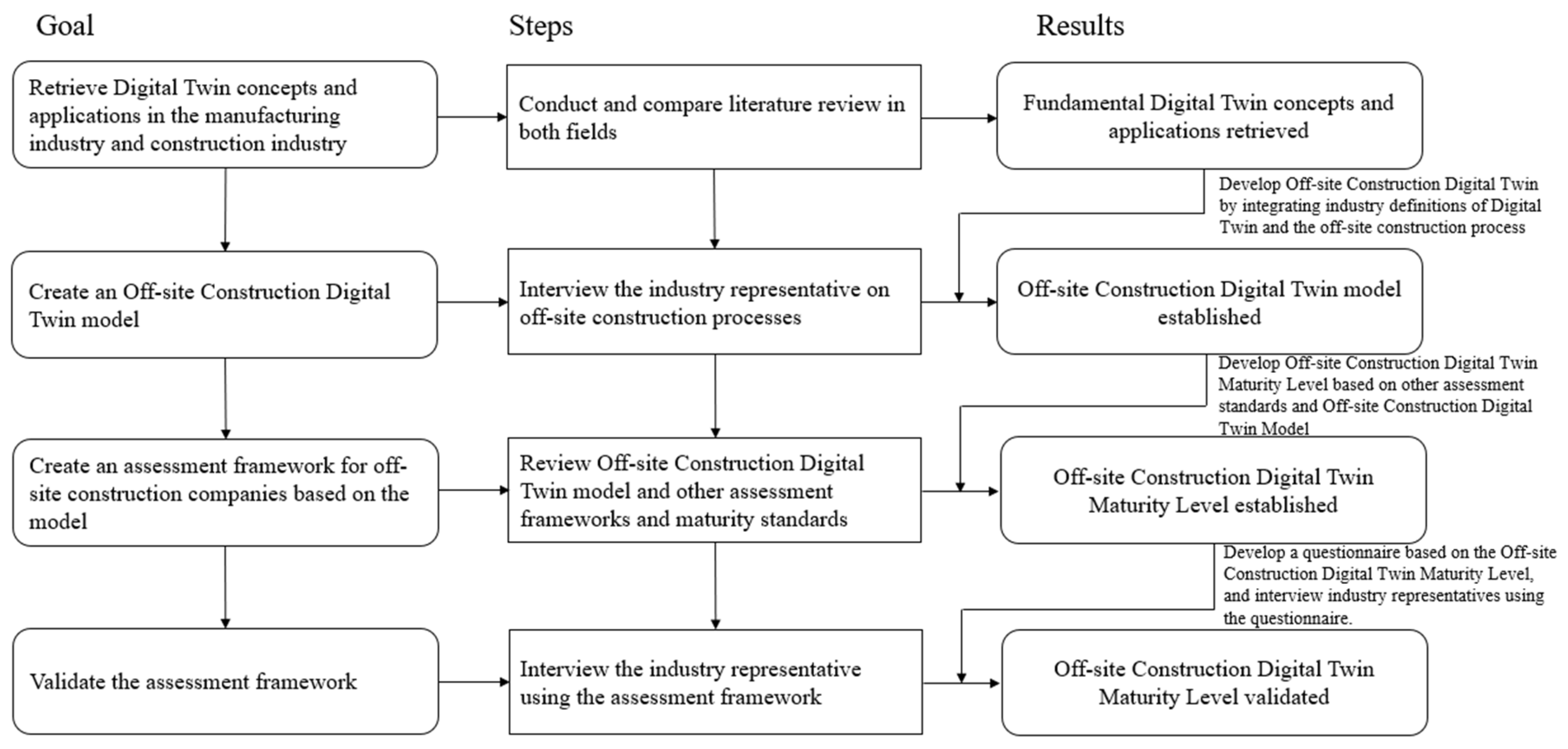
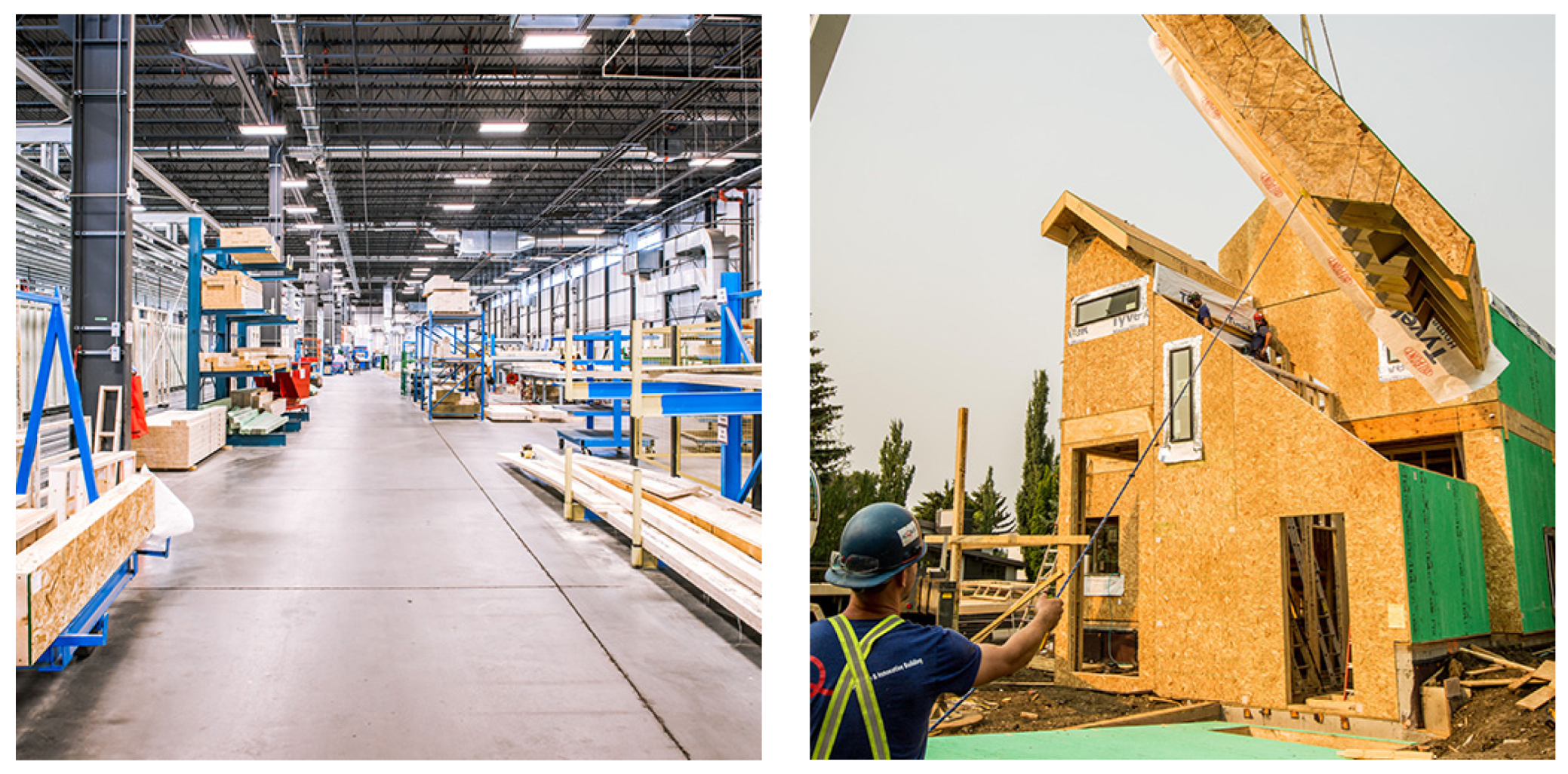
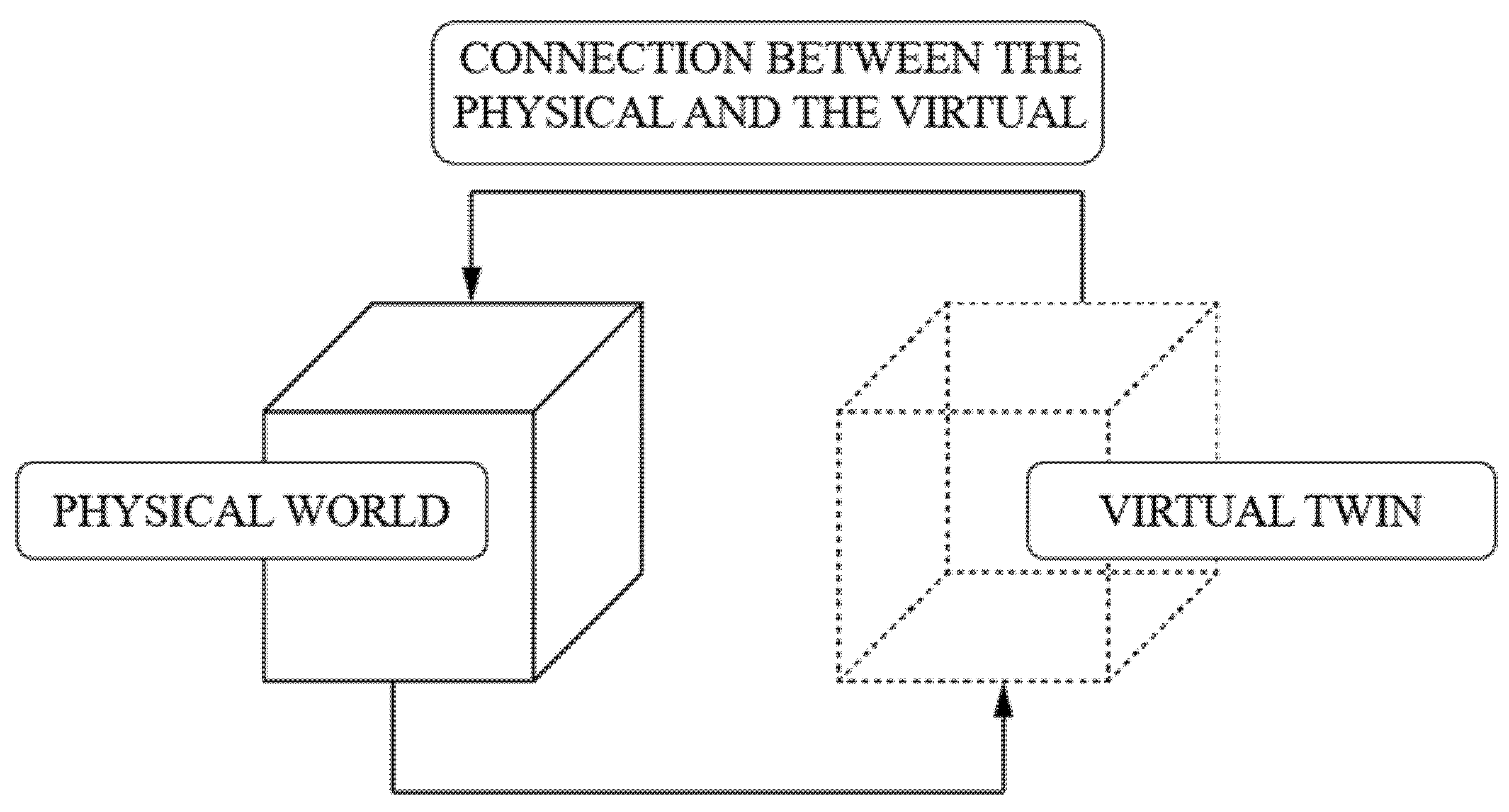
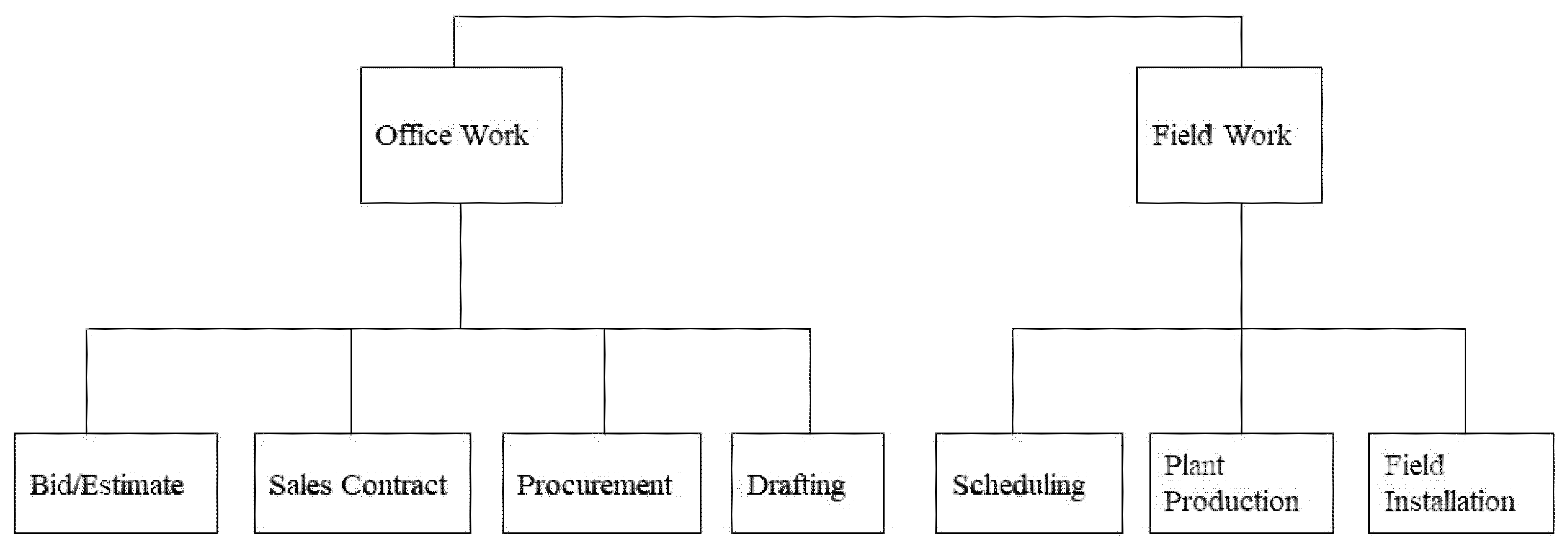
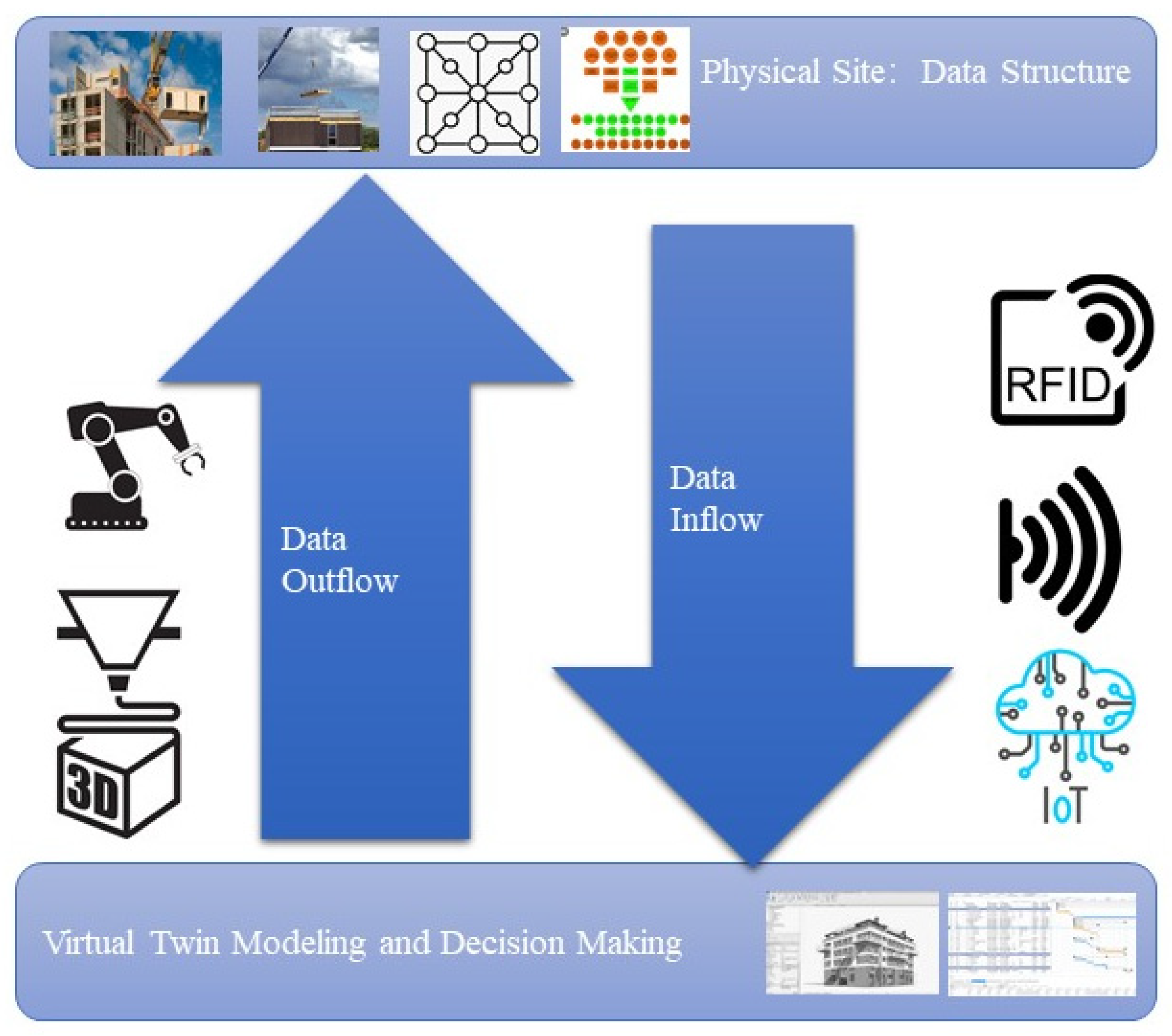
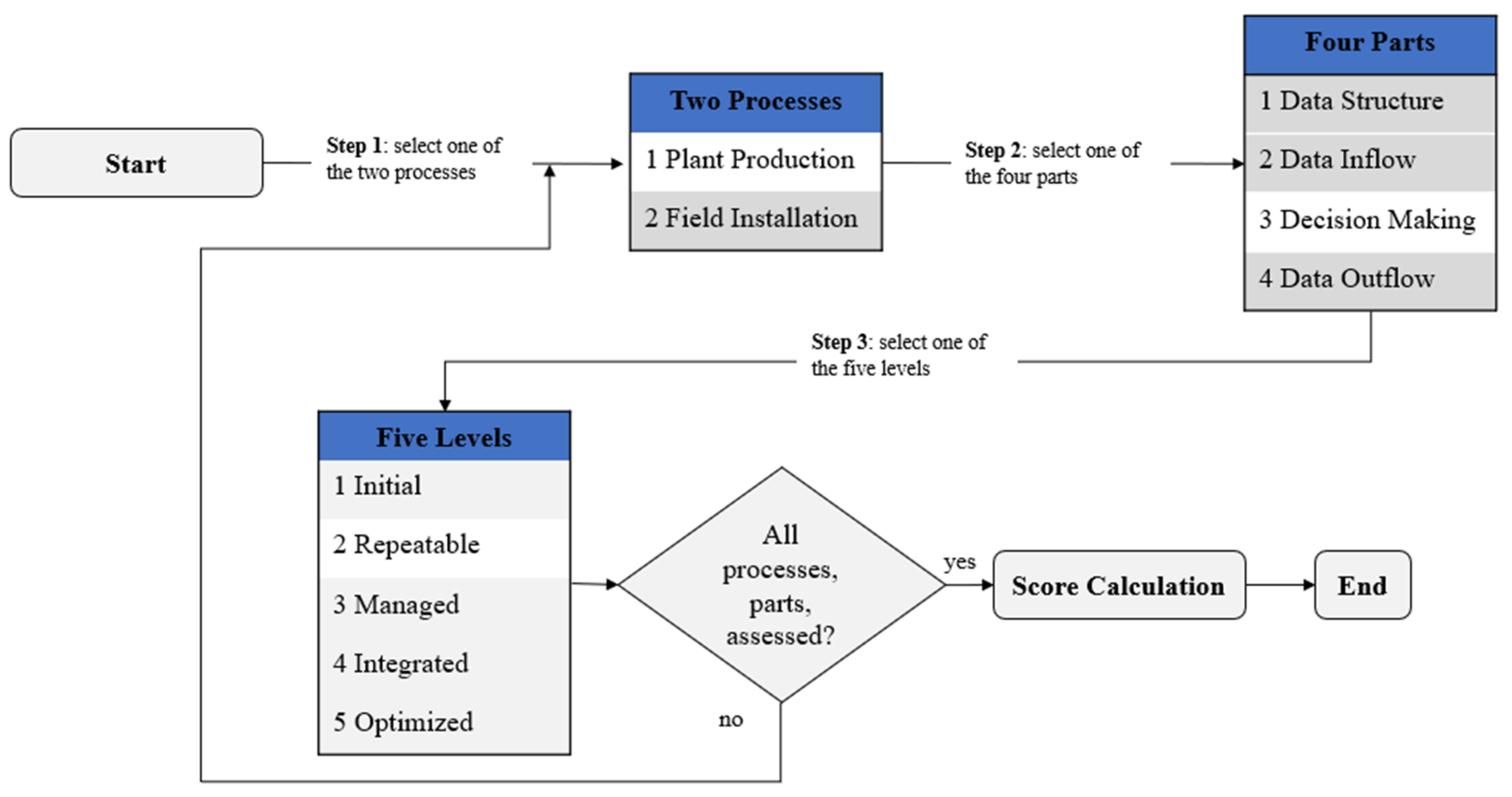

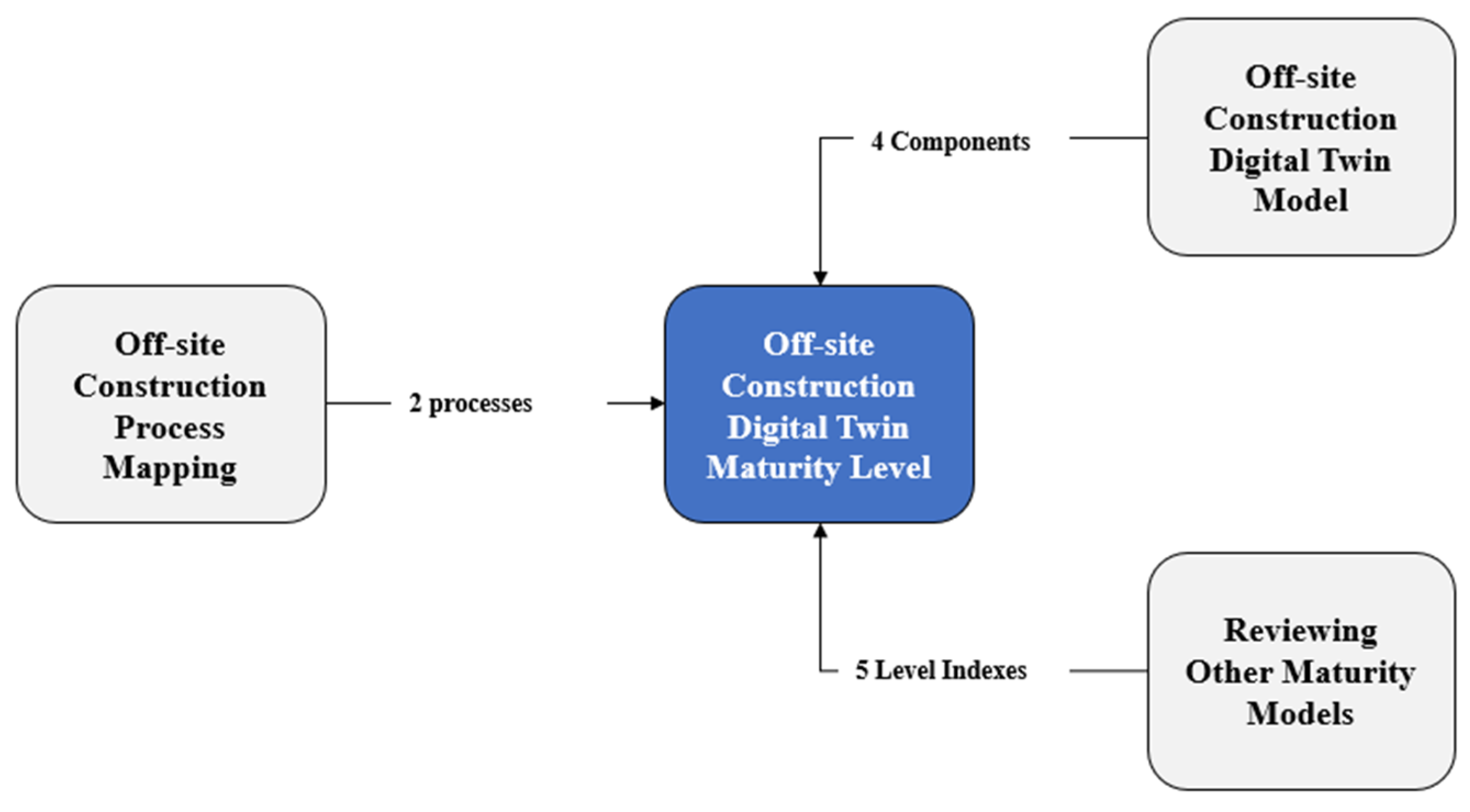
| DT: 4 Parts | DTML-1: Data Structure DTML-1 refers to the idea that the company defines standard processes in its off-site construction supply chain, factory, and site. This standard process is abstracted into a data structure that sets the foundation for Off-site Construction Digital Twin. | DTML-2: Data Inflow DTML-2 refers to the idea that the company establishes automated data inflow from the supply chain, factory, and construction site to the virtual side. | DTML-3: Decision Making/Virtual Twin Modeling DTML-3 refers to the idea that the company implements a virtual decision-making program to use data inflow from the physical side to make decisions/optimizations. | DTML-4: Data Outflow DTML-4 refers to the idea that the company establishes a data outflow stream to execute virtual decisions in the physical world. | |
| Level | |||||
| Level 1: Initial | The process is unorganized, and the processes may vary each time, depending on the person in charge. | Technologies are not adequate. Data collection only happens when required. Hardware updates and installation are operated when unavoidable. | Manually detect where to optimize/modify based on observations in factories and on site. | Manual execution upon receiving orders from the virtual side. | |
| Level 2: Repeatable | The data structure is partially defined for certain operations that make it repeatable for those who do the work but are not systematically organized. | Mostly manual inputs of the data from the physical side to the database, with some automated sensors collecting data on-site and in the factory. The automated process has multiple application scenarios. | Automated decision making is unified within a project team. The planning and management of projects are always based on previous similar projects. | Some project teams adopt actuators (sensors, robotic arms) in certain processes on site to execute orders from the virtual side, and the work schedules can be generated automatically. | |
| Level 3: Defined | Most of the processes are standardized, and most of the product data, process data, and resource data are categorized (data structure well-defined for a project cycle, e.g., ER diagram fully established). | The process of automated data collection is well-defined and deployed in certain processes for all projects, e.g., panel cutting and punching processes are reflected in computer systems in real time. | All decision makings necessary for the physical side are completed automatically on the virtual side, and the typical process is well-defined across the organization for all projects. | All the execution work is based on the Virtual Twin decision making and has typical processes defined for all projects. | |
| Level 4: Managed | All processes are well-synchronized across projects and tightly integrated with business processes. Interoperable data usage, storage, and exchange are treated as part of organizational strategy. | The technologies and data collection process have clear standards across the organization. There are quantitative goals to measure the quality of data inflow. | There are quantitative measurements for the level of quality achieved in the process. There are measurements for the quality of the decisions. | The quality of this automated execution is well-controlled with quantitative measurement tools. | |
| Level 5: Optimized | Based on Level 5, there are projects to continuously optimize data usage, storage, and exchange. | All the required data are collected automatically via a system that can bridge in new processes and new technologies. | Continuous software improvement including user interface, code efficiency, visualization, etc. | The data outflow process is continuously improving with new technologies, better adoption, and more efficient processes. | |
| Digital Twin Maturity Level Assessment Result: ACQBuilt | ||||||
|---|---|---|---|---|---|---|
| Level 1: 4 pts | Level 2: 8 pts | Level 3: 12 pts | Level 4: 16 pts | Level 5: 20 pts | ||
| Plant Production | Data Structure | ● | ||||
| Data Inflow | ● | |||||
| Decision Making | ● | |||||
| Data Outflow | ● | |||||
| Field Installation | Data Structure | ● | ||||
| Data Inflow | ● | |||||
| Decision Making | ● | |||||
| Data Outflow | ● | |||||
| Subtotal | 12 | 24 | 24 | 0 | 0 | |
| Total Points | 60 | |||||
| Maturity Score | 37.5 | |||||
Publisher’s Note: MDPI stays neutral with regard to jurisdictional claims in published maps and institutional affiliations. |
© 2022 by the authors. Licensee MDPI, Basel, Switzerland. This article is an open access article distributed under the terms and conditions of the Creative Commons Attribution (CC BY) license (https://creativecommons.org/licenses/by/4.0/).
Share and Cite
Wei, Y.; Lei, Z.; Altaf, S. An Off-Site Construction Digital Twin Assessment Framework Using Wood Panelized Construction as a Case Study. Buildings 2022, 12, 566. https://doi.org/10.3390/buildings12050566
Wei Y, Lei Z, Altaf S. An Off-Site Construction Digital Twin Assessment Framework Using Wood Panelized Construction as a Case Study. Buildings. 2022; 12(5):566. https://doi.org/10.3390/buildings12050566
Chicago/Turabian StyleWei, Yuxi, Zhen Lei, and Sadiq Altaf. 2022. "An Off-Site Construction Digital Twin Assessment Framework Using Wood Panelized Construction as a Case Study" Buildings 12, no. 5: 566. https://doi.org/10.3390/buildings12050566
APA StyleWei, Y., Lei, Z., & Altaf, S. (2022). An Off-Site Construction Digital Twin Assessment Framework Using Wood Panelized Construction as a Case Study. Buildings, 12(5), 566. https://doi.org/10.3390/buildings12050566







